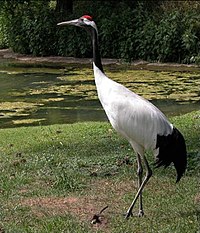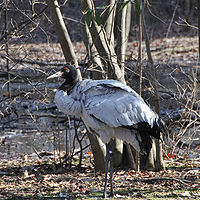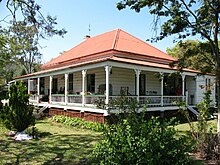그루스(게누스)
Grus (genus)| 그루스 | |
|---|---|
 | |
| 커먼 크레인(그루스 그루스) | |
| 과학적 분류 | |
| 킹덤: | 동물계 |
| Phylum: | 척색 동물문. |
| 클래스: | 조류 |
| 순서: | 그루이목 |
| 패밀리: | 그루이다이아과 |
| 지누스: | 그루스 브리송로1760번길 |
| 모식종 | |
| 그루스그루스 | |
| 종 | |
| 본문을 보다 | |
| 동의어 | |
| |
그루스 속은 1760년 프랑스의 동물학자 마투린 자크 브리송에 의해 세워졌다.[1] 그루스라는 이름은 "크레인"[2]을 뜻하는 라틴어다. 독일의 조류학자 피터 사이먼 팔라스(Peter[3] Simon Pallas)는 1766년에 속주를 세운 공로를 인정받았지만, 1956년 국제동물학명위원회는 브리송에게 우선권이 있어야 한다고 판결했다.[4]
그 속은 이전에 추가 종을 포함했다. 2010년에 발표된 분자 계통생성학 연구는 당시 정의된 대로 그루스 속은 다혈질이라는 것을 발견했다.[5] 그 결과 단핵생성을 만들기 위한 재배열에서 샌드힐 크레인, 재두루미, 사러스 크레인, 브로가 등은 1853년 독일의 자연주의자 루드비히 레이첸바흐가 세운 부활한 안티고네로 옮겨졌다.[6][7] 시베리아 두루미는 부활한 단성생식인 레우코게라누스로 옮겨졌다.[6]
종
속은 다음과 같은 8가지 종을 포함한다.[6]
| 이미지 | 학명 | 공용 이름 | 분포 |
|---|---|---|---|
 | 그루스카룬쿨라타 | 와틀드 크레인 | 사하라 사막 남쪽의 아프리카. |
 | 그루스 파라다이스 | 블루크레인 | 남아프리카 공화국 |
 | 그루스 처녀자리 | 데모젤크레인 | 중앙 유라시아, 흑해에서 몽골, 중국 북동부까지. 터키에도 적은 수의 사육 인구가 있다. |
 | 그루스자포넨시스 | 재두루미 | 시베리아(러시아 동부), 중국 북동부, 홋카이도(일본 북부), 한반도, 가끔 몽골 북동부에 있다. |
 | 아메리카나 | 후핑크레인 | 북아메리카 |
 | 그루스그루스 | 커먼크레인 | 유럽 |
 | 그루스 모나차 | 후드 크레인 | 중국 몽골 시베리아 중남부와 남동부. |
 | 그루스 니그리콜리스 | 흑목크레인 | 티베트 고원과 인도와 부탄의 외딴 지역. |
HBW/BirdLife 및 Clements 체크리스트는 데모아젤 크레인과 블루 크레인을 인류아데스속, 와트드 크레인을, 와트드 크레인은 단일 속 부게라누스에 배치하여 그루스속에는 홍관, 백관, 공통, 후드, 흑목 두루미만이 남게 된다.[8][9][10][11]
쿠바의 날지 못하는 학인 그루스 큐벤시스는 플레스토세에서 멸종되었다.[12]
화석 기록
이 종의 화석 기록은 약 1,200만 년 전으로 거슬러 올라간다. 많은 선사시대 종들이 알려져 있는데, 가장 오래된, 그루스 미오케니쿠스(루마니아 크레디누다의 미오세네 중)는 아마도 학이 아니라 수영-플라밍고 팔라엘로두스의 후배의 동의어인 것으로 알려져 있다. ("그루스" 문제는 확실히 그렇다.) 후기 플리스토세 지중해 그루스 프리미게니아는 석기시대 인간들에 의해 사냥되었다.
- G. 펜텔레시와는 의심스러울 정도로 구별되는 Grus afghana(아프가니스탄 몰라얀의 후기 미오세네)
- Grus sp. 1 (Late Miocene of Love Bone Bed, 미국)
- Grus sp. 2 (Love Bone Bed, USA의 Late Miocene)
- 그루스 cf. 안티고네(Late Miocene/Early Pliocene of Lee Creek Mine, 미국)
- 그루스 나노드(Late Miocene/Early Pliocene -? 미국 셔먼 카운티의 에드슨 미들 플리오세)
- 그루스 sp. (Late Miocene/Early Pliocene of Lee Creek Mine, 미국)
- 그루스 하이데니(Late Miocene/Early Pliocene - 플리스토세? WC USA) - 2종, G.캐나다와 동일할 수 있음
- Grus Pentelci(Late Miocene - C와 SE Europe의 초기 플리오세) - 이전에 플리오그루스(Pliogrus)에서
- 그루스 sp. (스페인 푸에블라 데 발베르데의 후기 플리오세)
- 그루스 보고체비(아제르바이잔의 후기 플리스토세) - 의심스러울 정도로 뚜렷한 형태 G. 원시유전체아
- 그루스 래티프스(W Atlantic, Bermuda의 Shore Hills Late Pleistocene) - 이전에는 Baeopteryx.
- 몰타 학 그루스 멜리텐시스(몰타 후기 플리스토세) - 의심스러울 정도로 G. 프라이미게니아와 구별됨
- 그루스 페이기 (란초 라 브레아의 후기 플리스토세)
- 그루스 프리미게니아(Late Pleistocene? SW유럽 출신)
- 그루스 큐벤시스(쿠바의 페리스토세·홀로세네)
몇몇 다른 화석들은 현재 여기에 속하지 않는 것으로 간주되고 있다. "그루스" 프렌티시는 현재 파라그루스, "그루스" 왕자, "그루스" 엑셀사와 "그루스" 호드웰리아누스는 팔래오그루스, "그루스" 엑셀리아누스는 발레이카에 배치되어 있다. "그루스" 마르시는 알레토니스에 속해 있다.
더욱 불확실한 것은 골보시카(몰다비아)와 다른 곳에서의 프로발라이카(Late Oliocene to Middle Pliocene, 그러나 아마도 Late Miocene)의 입지가 될 것이다. 그것은 보통 명목상의 두비움으로 여겨지지만 그뤼스에 속할 수도 있다. 「그루스」 컨페르타(미국 콘트라 코스타 카운티의 후기 미오세/얼리 플리오세)는 분명히 여기에 놓일 현대의 속과는 너무 다르지만, 제휴관계는 잘 해결되지 않는다.
참조
- ^ Brisson, Mathurin Jacques (1760). Ornithologie, ou, Méthode contenant la division des oiseaux en ordres, sections, genres, especes & leurs variétés (in French and Latin). Vol. Volume 5. Paris: Jean-Baptiste Bauche. pp. 374–375.
{{cite book}}:volume=추가 텍스트(도움말) - ^ Jobling, James A. (2010). The Helm Dictionary of Scientific Bird Names. London: Christopher Helm. p. 179. ISBN 978-1-4081-2501-4.
- ^ Peters, James Lee, ed. (1934). Check-list of Birds of the World. Vol. Volume 2. Cambridge, Massachusetts: Harvard University Press. p. 150.
{{cite book}}:volume=추가 텍스트(도움말) - ^ Hemming, Francis, ed. (1956). "Direction 55: Insertion in the Official List of Generic Names in Zoology of an entry relating to the generic name Grus Brisson, 1760 (Class Aves) (correction of an error in the Ruling given in Opinion 103)". Opinions and Declarations Rendered by the International Commission on Zoological Nomenclature. Vol. Volume 1 Section D Part D.16. London: International Trust for Zoological Nomenclature. pp. 319–336.
{{cite book}}:volume=추가 텍스트(도움말) - ^ Krajewski, C.; Sipiorski, J.T.; Anderson, F.E. (2010). "Mitochondrial genome sequences and the phylogeny of cranes (Gruiformes: Gruidae)". Auk. 127 (2): 440–452. doi:10.1525/auk.2009.09045.
- ^ a b c Gill, Frank; Donsker, David, eds. (2019). "Flufftails, finfoots, rails, trumpeters, cranes, limpkin". World Bird List Version 9.2. International Ornithologists' Union. Retrieved 26 June 2019.
- ^ Reichenbach, Ludwig (1853). Handbuch der speciellen Ornithologie (in German). Leipzig: Friedrich Hofmeister. p. xxiii.
- ^ Archibald, G.W.; Meine, C.D.; Garcia, E.F.J.; Kirwan, G.M. (2017). del Hoyo, J.; Elliott, A.; Sargatal, J.; Christie, D.A.; de Juana, E. (eds.). "Demoiselle Crane (Anthropoides virgo)". Handbook of the Birds of the World Alive. Lynx Edicions. Retrieved 12 November 2017.
- ^ Archibald, G.W.; Meine, C.D.; Garcia, E.F.J. (2017). del Hoyo, J.; Elliott, A.; Sargatal, J.; Christie, D.A.; de Juana, E. (eds.). "Blue Crane (Anthropoides paradiseus)". Handbook of the Birds of the World Alive. Lynx Edicions. Retrieved 12 November 2017.
- ^ Archibald, G.W.; Meine, C.D.; Garcia, E.F.J. (2017). del Hoyo, J.; Elliott, A.; Sargatal, J.; Christie, D.A.; de Juana, E. (eds.). "Wattled Crane (Bugeranus carunculatus)". Handbook of the Birds of the World Alive. Lynx Edicions. Retrieved 12 November 2017.
- ^ Clements, J.F.; Schulenberg, T.S.; Iliff, M.J.; Roberson, D.; Fredericks, T.A.; Sullivan, B.L.; Wood, C.L. (2017). "The eBird/Clements checklist of birds of the world: v2017". Retrieved 12 November 2017.
- ^ Olson, Storrs L. (1978). "A paleontological perspective of West Indian birds and mammals" (PDF). In Gill, Frank (ed.). Zoogeography in the Caribbean: The 1975 Leidy Medal Symposium. Special Publication 13. Academy of Natural Sciences of Philadelphia. pp. 99–117 [106]. ISBN 1422317854.


